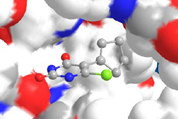Projects

|
Synthesis of conformationally locked carbocyclic nucleosidesThe search for new modified nucleosides as antivirals has been promising field of research. Carbocyclic nucleosides in which the oxygen of the hemiacetal moiety is replaced by a methylene group, possess enhanced biostability due to the absence of this acid labile hemiacetal group. The discovery of the antibiotic and antitumor activity of the natural carbocyclic nucleosides aristeromycin and neplanocin A stimulated search for novel carbocyclic nucleoside analogues, and indeed, additional synthetic carbocyclic nucleosides with important therapeutic properties were discovered. Within the scope of this project we are recently dealing with the syntheses of novel nucleoside analogues wherein the sugar moiety is replaced by substituted norbornane, which represents conformationally locked carbapentofuranose and/or carbahexopyranose systems. It also comprises the evaluation of antiviral activity of the prepared compounds. Most of these compounds exhibit activity against Coxsackie viruses. These are small cytolytic viruses, which belong to the Enterovirus genus within the Picornaviridae family. Clinical manifestations associated with enteroviruses range from mild illnesses, such as fever, rash, hand-foot-mouth syndrome, and herpangina, to serious life-threatening infections, such as meningitis, encephalitis, myocarditis, pancreatitis, acute paralysis, or neonatal sepsis. There is currently no approved therapy for treatment of enteroviral infections. |

|
Synthesis of thymidine phosphorylase inhibitorsVarious enzymes involved in the nucleic acid metabolism play an essential role in the processes of pathogenic microorganisms replication and tumor cells growth. In recent years, the knowledge of three-dimensional structure of enzymes’ active sites has allowed rational design of novel inhibitors and hence their further application in therapy of many serious diseases. In our team we design and synthesize inhibitors of both viral enzymes (mainly viral polymerases and reverse transcriptases) and human enzymes participating in the process of tumor growth and nutrition. One of the key enzymes in this process is thymidine phosphorylase, which plays a crucial role in the angiogenesis (proliferation of new blood vessels in order to nourish the tumor). |